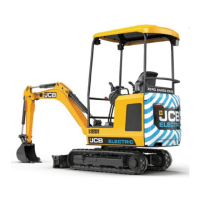Operation
Operating Safety
• Controlled patterns of machine movement
• A system of communication.
You and/or your company could be legally liable for any damage you may cause to public utilities. It is your
responsibility to make sure that you know the locations of any public utility cables or pipes on the worksite
which could be damaged by your machine.
Risk Assessment
It is the responsibility of the competent people that plan the work and operate the machine to make a judgement
about the safe use of the machine, they must take into account the specific application and conditions of use
at the time.
It is essential that a risk assessment of the work to be done is completed and that the operator obeys any
safety precautions that the assessment identifies.
If you are unsure of the suitability of the machine for a specific task, contact your JCB dealer who will be
pleased to advise you.
The following considerations are intended as suggestions of some of the factors to be taken into account when
a risk assessment is made. Other factors may need to be considered.
A good risk assessment depends on the training and experience of the operator. Do not put your life or the
lives of others at risk.
Personnel
• Are all persons who will take part in the operation sufficiently trained, experienced and competent? Are
they fit and sufficiently rested? A sick or tired operator is a dangerous operator.
• Is supervision needed? Is the supervisor sufficiently trained and experienced?
• As well as the machine operator, are any assistants or lookouts needed?
The Machine
• Is it in good working order?
• Have any reported defects been corrected?
• Have the daily checks been carried out?
The Load
• How heavy is it? Is it within the capabilities of the machine?
• How bulky is it? The greater the surface area, the more affected it will be by wind speeds.
• Is it an awkward shape? How is the weight distributed? Uneven loads are more difficult to handle.
• Is there a possibility of the load shifting while being moved?
Loading/Unloading Area
• Is it level? Any slope of more than 2.5% (1 in 40) must be carefully considered.
• Is more than one direction of approach to the load possible? Approaching across the slope must be
avoided, if possible.
• Is the ground solid? Will it support the weight of the machine when loaded?
• How rough is the ground? Are there any sharp projections which could cause damage, particularly to
the tyres?
• Are there any obstacles or hazards in the area, for example, debris, excavations, manhole covers, power
lines?
• Is the space sufficient for safe manoeuvring?
• Are any other machines or persons likely to be in or to enter the area while operations are in progress?
The Route to be Travelled
• How solid is the ground, will it provide sufficient traction and braking? Soft ground will affect the stability
of the machine and this must be taken into account.
25 9831/8250-4 25
JCB © Admin Pimteam - 23/06/2021 05:32.

